Accounting and Finance Report: Racca Ltd and Rockham Plc Analysis
VerifiedAdded on 2023/06/07
|14
|3538
|109
Report
AI Summary
This report, prepared for an Introduction to Accounting and Finance course, encompasses three main parts. Part 1 focuses on the preparation of financial statements, including the income statement and statement of financial position for Racca Limited. Part 2 delves into marginal costing, calculating contribution, break-even points, and margin of safety, with a case study on Stockstone Ltd, evaluating a new marketing strategy. Part 3 explores capital investment techniques, including net present value, payback period, and accounting rate of return, with a case study on Rockham Plc, offering investment recommendations and discussing the advantages and disadvantages of budgets. The report provides detailed calculations, analysis, and recommendations based on the application of these accounting and finance principles.

Introduction to
Accounting and Finance
Accounting and Finance
Paraphrase This Document
Need a fresh take? Get an instant paraphrase of this document with our AI Paraphraser

Contents
INTRODUCTION...........................................................................................................................1
Part 1 ...............................................................................................................................................1
Income statement.........................................................................................................................2
Statement of financial position ...................................................................................................2
PART 2............................................................................................................................................3
a) calculation of contribution ......................................................................................................3
b) Calculation of break even point (BEP) and margin of safety (MOS) in terms of revenue and
units :............................................................................................................................................3
c ) Computation of profit for Stockstone Ltd when they produce 48000 electric kettle ............4
Evaluation of new strategy whether to adopt this or not for Stockstone Ltd...............................4
E ) Assumptions of break even model and analysis of the model used successfully in different
types of business :........................................................................................................................5
PART 3............................................................................................................................................6
Part C – Rockham Plc. ....................................................................................................................6
a. The calculations of various appraisal techniques.....................................................................6
b. Investment appraisal techniques ............................................................................................8
c. The advantages and disadvantages of budgets.........................................................................9
CONCLUSIONS............................................................................................................................10
REFERENCES..............................................................................................................................10
INTRODUCTION...........................................................................................................................1
Part 1 ...............................................................................................................................................1
Income statement.........................................................................................................................2
Statement of financial position ...................................................................................................2
PART 2............................................................................................................................................3
a) calculation of contribution ......................................................................................................3
b) Calculation of break even point (BEP) and margin of safety (MOS) in terms of revenue and
units :............................................................................................................................................3
c ) Computation of profit for Stockstone Ltd when they produce 48000 electric kettle ............4
Evaluation of new strategy whether to adopt this or not for Stockstone Ltd...............................4
E ) Assumptions of break even model and analysis of the model used successfully in different
types of business :........................................................................................................................5
PART 3............................................................................................................................................6
Part C – Rockham Plc. ....................................................................................................................6
a. The calculations of various appraisal techniques.....................................................................6
b. Investment appraisal techniques ............................................................................................8
c. The advantages and disadvantages of budgets.........................................................................9
CONCLUSIONS............................................................................................................................10
REFERENCES..............................................................................................................................10
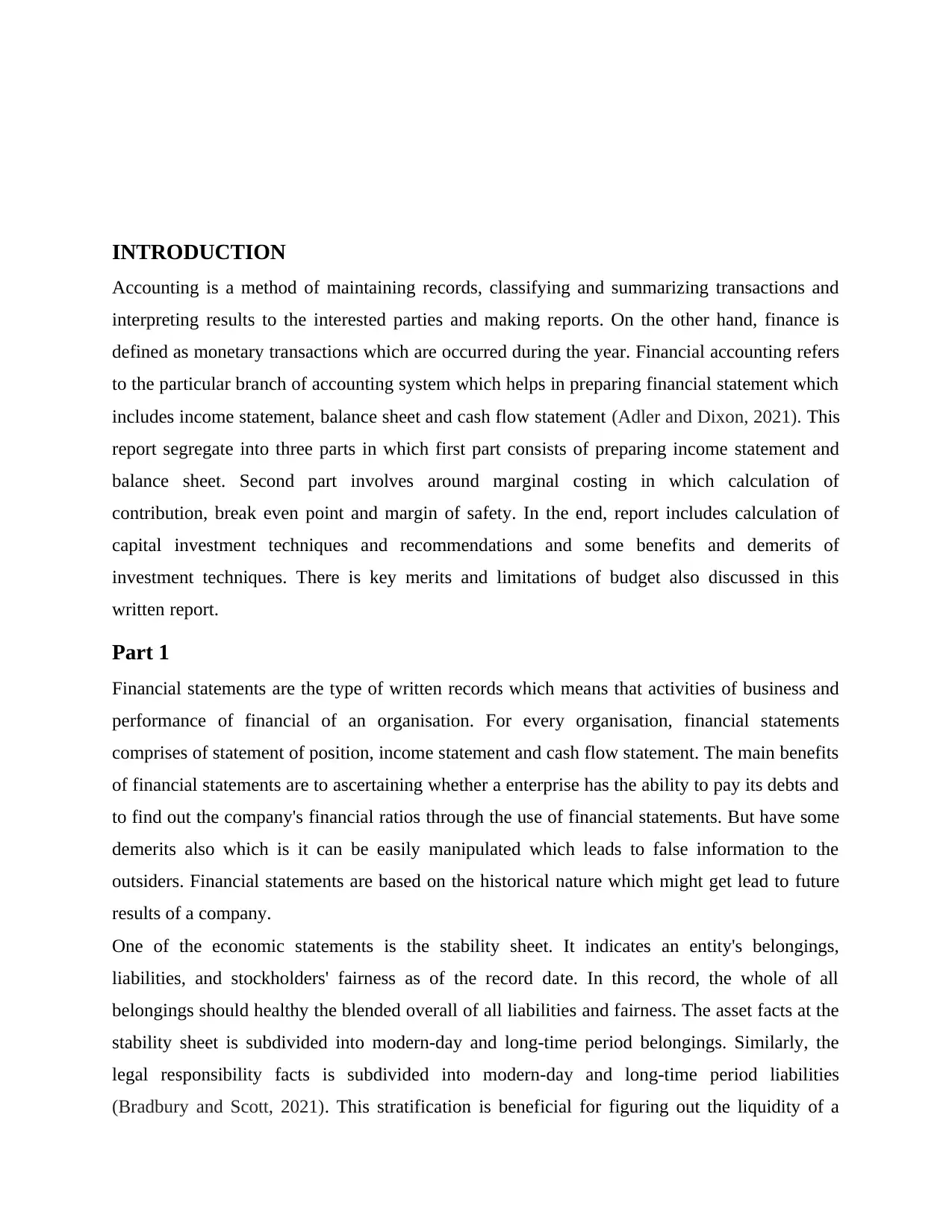
INTRODUCTION
Accounting is a method of maintaining records, classifying and summarizing transactions and
interpreting results to the interested parties and making reports. On the other hand, finance is
defined as monetary transactions which are occurred during the year. Financial accounting refers
to the particular branch of accounting system which helps in preparing financial statement which
includes income statement, balance sheet and cash flow statement (Adler and Dixon, 2021). This
report segregate into three parts in which first part consists of preparing income statement and
balance sheet. Second part involves around marginal costing in which calculation of
contribution, break even point and margin of safety. In the end, report includes calculation of
capital investment techniques and recommendations and some benefits and demerits of
investment techniques. There is key merits and limitations of budget also discussed in this
written report.
Part 1
Financial statements are the type of written records which means that activities of business and
performance of financial of an organisation. For every organisation, financial statements
comprises of statement of position, income statement and cash flow statement. The main benefits
of financial statements are to ascertaining whether a enterprise has the ability to pay its debts and
to find out the company's financial ratios through the use of financial statements. But have some
demerits also which is it can be easily manipulated which leads to false information to the
outsiders. Financial statements are based on the historical nature which might get lead to future
results of a company.
One of the economic statements is the stability sheet. It indicates an entity's belongings,
liabilities, and stockholders' fairness as of the record date. In this record, the whole of all
belongings should healthy the blended overall of all liabilities and fairness. The asset facts at the
stability sheet is subdivided into modern-day and long-time period belongings. Similarly, the
legal responsibility facts is subdivided into modern-day and long-time period liabilities
(Bradbury and Scott, 2021). This stratification is beneficial for figuring out the liquidity of a
Accounting is a method of maintaining records, classifying and summarizing transactions and
interpreting results to the interested parties and making reports. On the other hand, finance is
defined as monetary transactions which are occurred during the year. Financial accounting refers
to the particular branch of accounting system which helps in preparing financial statement which
includes income statement, balance sheet and cash flow statement (Adler and Dixon, 2021). This
report segregate into three parts in which first part consists of preparing income statement and
balance sheet. Second part involves around marginal costing in which calculation of
contribution, break even point and margin of safety. In the end, report includes calculation of
capital investment techniques and recommendations and some benefits and demerits of
investment techniques. There is key merits and limitations of budget also discussed in this
written report.
Part 1
Financial statements are the type of written records which means that activities of business and
performance of financial of an organisation. For every organisation, financial statements
comprises of statement of position, income statement and cash flow statement. The main benefits
of financial statements are to ascertaining whether a enterprise has the ability to pay its debts and
to find out the company's financial ratios through the use of financial statements. But have some
demerits also which is it can be easily manipulated which leads to false information to the
outsiders. Financial statements are based on the historical nature which might get lead to future
results of a company.
One of the economic statements is the stability sheet. It indicates an entity's belongings,
liabilities, and stockholders' fairness as of the record date. In this record, the whole of all
belongings should healthy the blended overall of all liabilities and fairness. The asset facts at the
stability sheet is subdivided into modern-day and long-time period belongings. Similarly, the
legal responsibility facts is subdivided into modern-day and long-time period liabilities
(Bradbury and Scott, 2021). This stratification is beneficial for figuring out the liquidity of a
⊘ This is a preview!⊘
Do you want full access?
Subscribe today to unlock all pages.

Trusted by 1+ million students worldwide
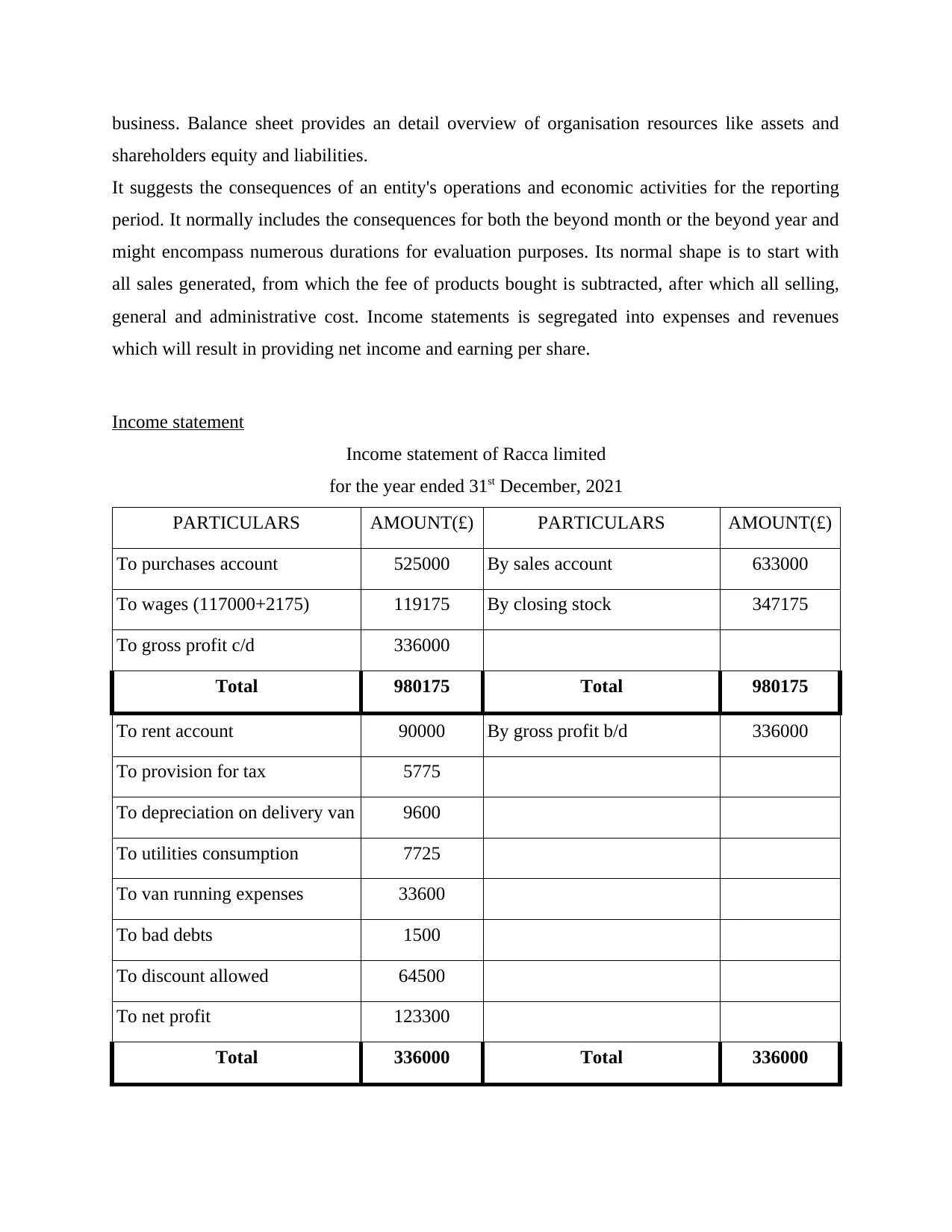
business. Balance sheet provides an detail overview of organisation resources like assets and
shareholders equity and liabilities.
It suggests the consequences of an entity's operations and economic activities for the reporting
period. It normally includes the consequences for both the beyond month or the beyond year and
might encompass numerous durations for evaluation purposes. Its normal shape is to start with
all sales generated, from which the fee of products bought is subtracted, after which all selling,
general and administrative cost. Income statements is segregated into expenses and revenues
which will result in providing net income and earning per share.
Income statement
Income statement of Racca limited
for the year ended 31st December, 2021
PARTICULARS AMOUNT(£) PARTICULARS AMOUNT(£)
To purchases account 525000 By sales account 633000
To wages (117000+2175) 119175 By closing stock 347175
To gross profit c/d 336000
Total 980175 Total 980175
To rent account 90000 By gross profit b/d 336000
To provision for tax 5775
To depreciation on delivery van 9600
To utilities consumption 7725
To van running expenses 33600
To bad debts 1500
To discount allowed 64500
To net profit 123300
Total 336000 Total 336000
shareholders equity and liabilities.
It suggests the consequences of an entity's operations and economic activities for the reporting
period. It normally includes the consequences for both the beyond month or the beyond year and
might encompass numerous durations for evaluation purposes. Its normal shape is to start with
all sales generated, from which the fee of products bought is subtracted, after which all selling,
general and administrative cost. Income statements is segregated into expenses and revenues
which will result in providing net income and earning per share.
Income statement
Income statement of Racca limited
for the year ended 31st December, 2021
PARTICULARS AMOUNT(£) PARTICULARS AMOUNT(£)
To purchases account 525000 By sales account 633000
To wages (117000+2175) 119175 By closing stock 347175
To gross profit c/d 336000
Total 980175 Total 980175
To rent account 90000 By gross profit b/d 336000
To provision for tax 5775
To depreciation on delivery van 9600
To utilities consumption 7725
To van running expenses 33600
To bad debts 1500
To discount allowed 64500
To net profit 123300
Total 336000 Total 336000
Paraphrase This Document
Need a fresh take? Get an instant paraphrase of this document with our AI Paraphraser
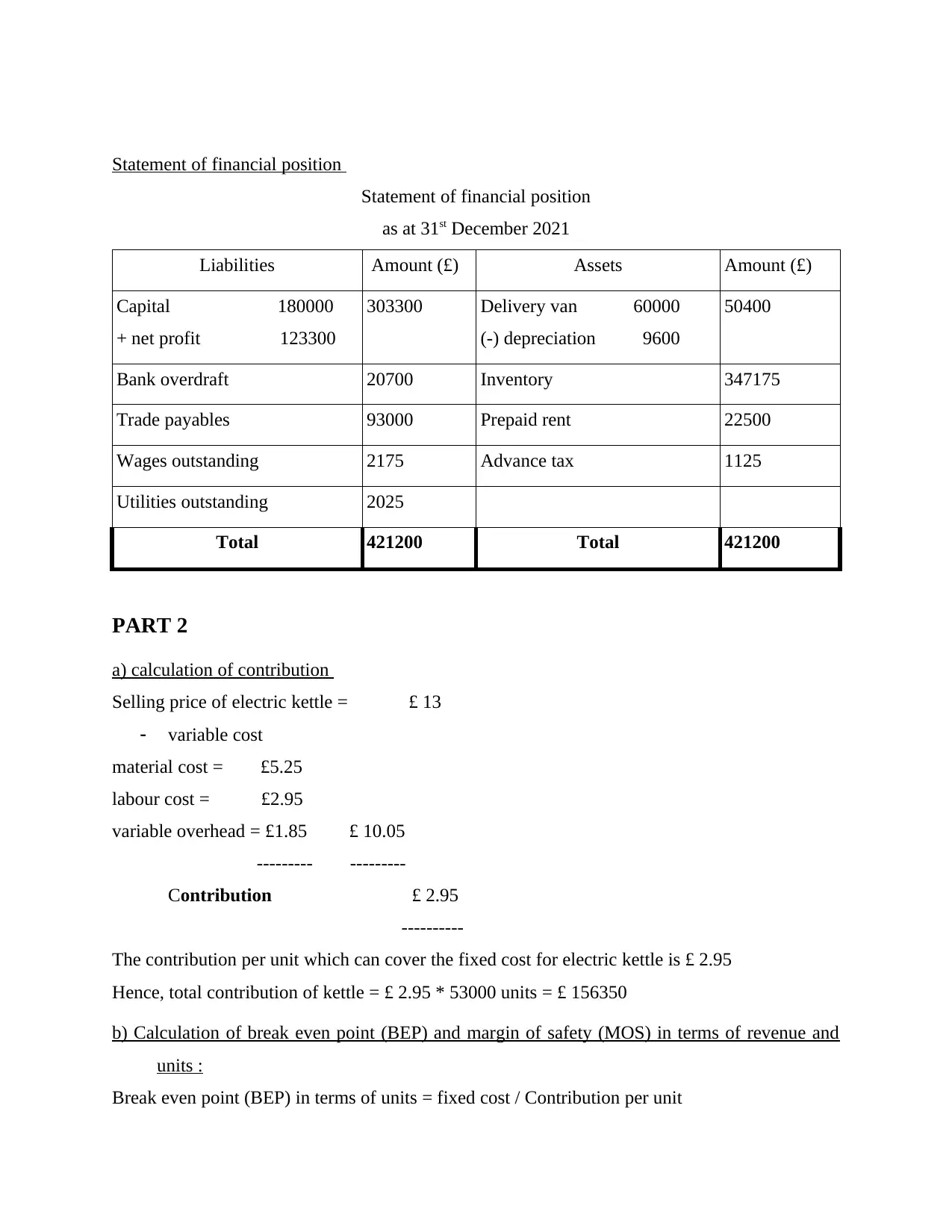
Statement of financial position
Statement of financial position
as at 31st December 2021
Liabilities Amount (£) Assets Amount (£)
Capital 180000
+ net profit 123300
303300 Delivery van 60000
(-) depreciation 9600
50400
Bank overdraft 20700 Inventory 347175
Trade payables 93000 Prepaid rent 22500
Wages outstanding 2175 Advance tax 1125
Utilities outstanding 2025
Total 421200 Total 421200
PART 2
a) calculation of contribution
Selling price of electric kettle = £ 13
variable cost
material cost = £5.25
labour cost = £2.95
variable overhead = £1.85 £ 10.05
--------- ---------
Contribution £ 2.95
----------
The contribution per unit which can cover the fixed cost for electric kettle is £ 2.95
Hence, total contribution of kettle = £ 2.95 * 53000 units = £ 156350
b) Calculation of break even point (BEP) and margin of safety (MOS) in terms of revenue and
units :
Break even point (BEP) in terms of units = fixed cost / Contribution per unit
Statement of financial position
as at 31st December 2021
Liabilities Amount (£) Assets Amount (£)
Capital 180000
+ net profit 123300
303300 Delivery van 60000
(-) depreciation 9600
50400
Bank overdraft 20700 Inventory 347175
Trade payables 93000 Prepaid rent 22500
Wages outstanding 2175 Advance tax 1125
Utilities outstanding 2025
Total 421200 Total 421200
PART 2
a) calculation of contribution
Selling price of electric kettle = £ 13
variable cost
material cost = £5.25
labour cost = £2.95
variable overhead = £1.85 £ 10.05
--------- ---------
Contribution £ 2.95
----------
The contribution per unit which can cover the fixed cost for electric kettle is £ 2.95
Hence, total contribution of kettle = £ 2.95 * 53000 units = £ 156350
b) Calculation of break even point (BEP) and margin of safety (MOS) in terms of revenue and
units :
Break even point (BEP) in terms of units = fixed cost / Contribution per unit
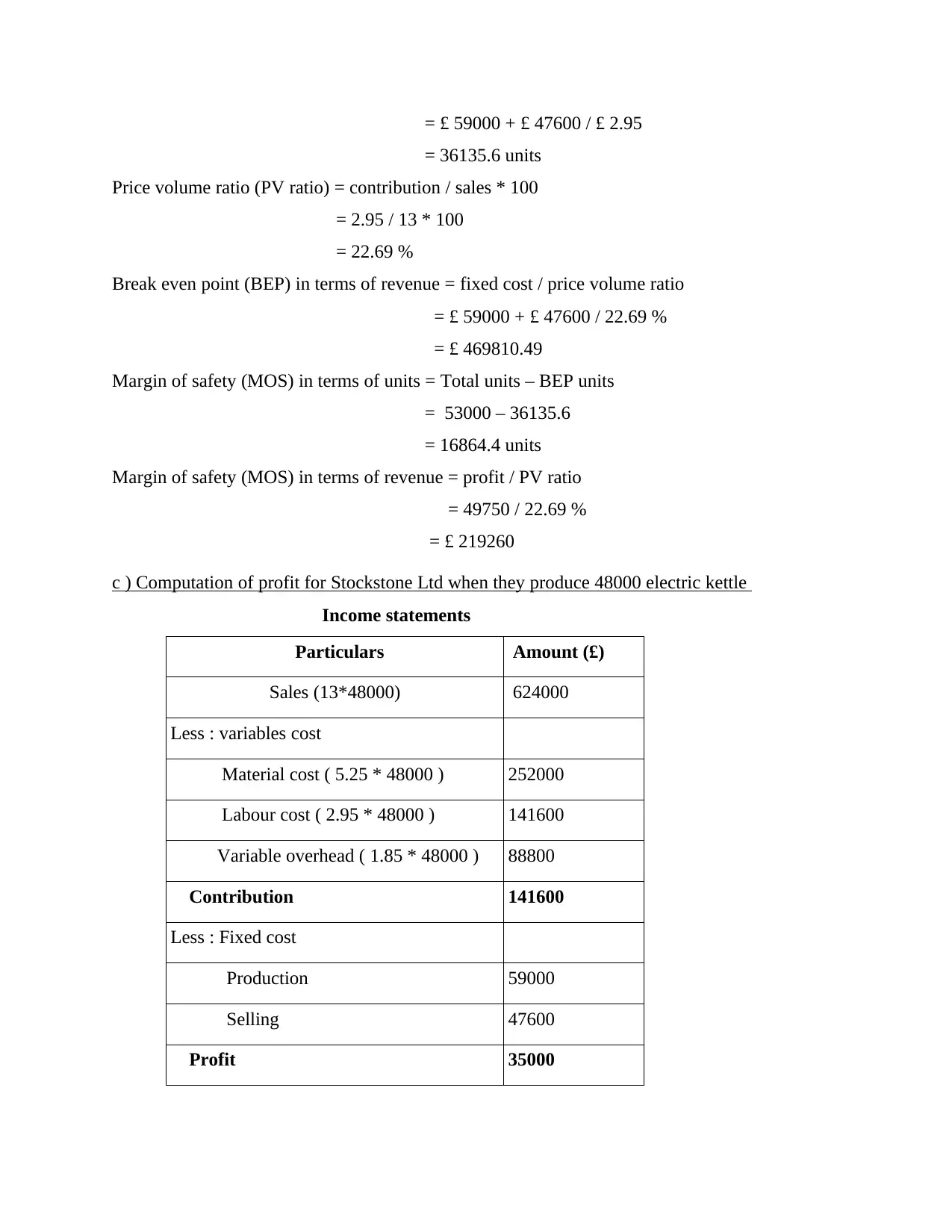
= £ 59000 + £ 47600 / £ 2.95
= 36135.6 units
Price volume ratio (PV ratio) = contribution / sales * 100
= 2.95 / 13 * 100
= 22.69 %
Break even point (BEP) in terms of revenue = fixed cost / price volume ratio
= £ 59000 + £ 47600 / 22.69 %
= £ 469810.49
Margin of safety (MOS) in terms of units = Total units – BEP units
= 53000 – 36135.6
= 16864.4 units
Margin of safety (MOS) in terms of revenue = profit / PV ratio
= 49750 / 22.69 %
= £ 219260
c ) Computation of profit for Stockstone Ltd when they produce 48000 electric kettle
Income statements
Particulars Amount (£)
Sales (13*48000) 624000
Less : variables cost
Material cost ( 5.25 * 48000 ) 252000
Labour cost ( 2.95 * 48000 ) 141600
Variable overhead ( 1.85 * 48000 ) 88800
Contribution 141600
Less : Fixed cost
Production 59000
Selling 47600
Profit 35000
= 36135.6 units
Price volume ratio (PV ratio) = contribution / sales * 100
= 2.95 / 13 * 100
= 22.69 %
Break even point (BEP) in terms of revenue = fixed cost / price volume ratio
= £ 59000 + £ 47600 / 22.69 %
= £ 469810.49
Margin of safety (MOS) in terms of units = Total units – BEP units
= 53000 – 36135.6
= 16864.4 units
Margin of safety (MOS) in terms of revenue = profit / PV ratio
= 49750 / 22.69 %
= £ 219260
c ) Computation of profit for Stockstone Ltd when they produce 48000 electric kettle
Income statements
Particulars Amount (£)
Sales (13*48000) 624000
Less : variables cost
Material cost ( 5.25 * 48000 ) 252000
Labour cost ( 2.95 * 48000 ) 141600
Variable overhead ( 1.85 * 48000 ) 88800
Contribution 141600
Less : Fixed cost
Production 59000
Selling 47600
Profit 35000
⊘ This is a preview!⊘
Do you want full access?
Subscribe today to unlock all pages.

Trusted by 1+ million students worldwide
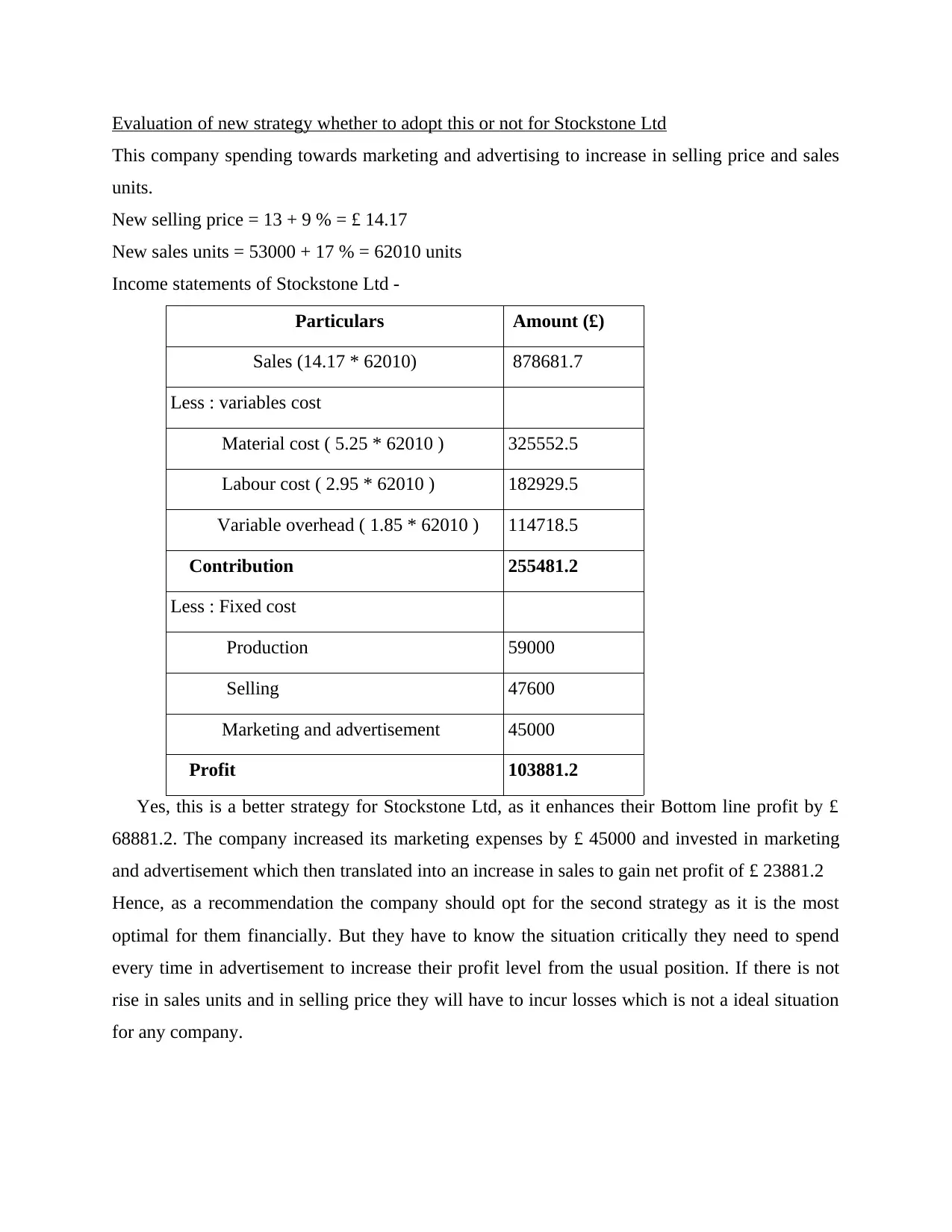
Evaluation of new strategy whether to adopt this or not for Stockstone Ltd
This company spending towards marketing and advertising to increase in selling price and sales
units.
New selling price = 13 + 9 % = £ 14.17
New sales units = 53000 + 17 % = 62010 units
Income statements of Stockstone Ltd -
Particulars Amount (£)
Sales (14.17 * 62010) 878681.7
Less : variables cost
Material cost ( 5.25 * 62010 ) 325552.5
Labour cost ( 2.95 * 62010 ) 182929.5
Variable overhead ( 1.85 * 62010 ) 114718.5
Contribution 255481.2
Less : Fixed cost
Production 59000
Selling 47600
Marketing and advertisement 45000
Profit 103881.2
Yes, this is a better strategy for Stockstone Ltd, as it enhances their Bottom line profit by £
68881.2. The company increased its marketing expenses by £ 45000 and invested in marketing
and advertisement which then translated into an increase in sales to gain net profit of £ 23881.2
Hence, as a recommendation the company should opt for the second strategy as it is the most
optimal for them financially. But they have to know the situation critically they need to spend
every time in advertisement to increase their profit level from the usual position. If there is not
rise in sales units and in selling price they will have to incur losses which is not a ideal situation
for any company.
This company spending towards marketing and advertising to increase in selling price and sales
units.
New selling price = 13 + 9 % = £ 14.17
New sales units = 53000 + 17 % = 62010 units
Income statements of Stockstone Ltd -
Particulars Amount (£)
Sales (14.17 * 62010) 878681.7
Less : variables cost
Material cost ( 5.25 * 62010 ) 325552.5
Labour cost ( 2.95 * 62010 ) 182929.5
Variable overhead ( 1.85 * 62010 ) 114718.5
Contribution 255481.2
Less : Fixed cost
Production 59000
Selling 47600
Marketing and advertisement 45000
Profit 103881.2
Yes, this is a better strategy for Stockstone Ltd, as it enhances their Bottom line profit by £
68881.2. The company increased its marketing expenses by £ 45000 and invested in marketing
and advertisement which then translated into an increase in sales to gain net profit of £ 23881.2
Hence, as a recommendation the company should opt for the second strategy as it is the most
optimal for them financially. But they have to know the situation critically they need to spend
every time in advertisement to increase their profit level from the usual position. If there is not
rise in sales units and in selling price they will have to incur losses which is not a ideal situation
for any company.
Paraphrase This Document
Need a fresh take? Get an instant paraphrase of this document with our AI Paraphraser

E ) Assumptions of break even model and analysis of the model used successfully in different
types of business :
Break even point is defined as mass of production and volume of gross sales where there exist
situation of no profit no loss (Cai, 2021). It assists company in finding out the relation between
the revenue and cost in accordance with company's output. In other words, in order to gain the
knowledge of break even point its better to understand the relationship between cost,volume and
profit. There exist some of the important use of Break-even is help in determining the effect of
change in volume, profit determination and ascertaining the comparability of profit for each
products. In marginal costing, there have to follow many assumption of implementing break
even point are :
all expenses which incurred in producing goods shall be segregate into variable and fixed
expenses.
For all level of output produced, the fixed expenses incurred irrespective of units sold
will remain constant .
For every change attached with output produced, variable cost will also change in
accordance with units .
The primary assumption for product mix is that it will remain same throughout the
reporting period.
When it comes to selling price it will also remain same for calculating the profit for each
level of output.
The quantity of output of income will coincide with the units produced in order that there
may be no commencing or final stock .
It has been assumed that productivity per labour or employees will remain constant.
But there is shortcoming also for break even analysis are discussed below :
1. As break even calculation is generally based on assumption that all the expenditure is
segregate into fixed and variable cost but in practical terms it is not possible to
accomplish clear cut division of costs(Dean and et.al., 2020).
2. As break-even analysis is purely based on fixed cost remain constant but it will change at
a time when level of activity go beyond a certain level.
3. In practical terms, one product is produced or product mix remain constant is not at all
possible.
types of business :
Break even point is defined as mass of production and volume of gross sales where there exist
situation of no profit no loss (Cai, 2021). It assists company in finding out the relation between
the revenue and cost in accordance with company's output. In other words, in order to gain the
knowledge of break even point its better to understand the relationship between cost,volume and
profit. There exist some of the important use of Break-even is help in determining the effect of
change in volume, profit determination and ascertaining the comparability of profit for each
products. In marginal costing, there have to follow many assumption of implementing break
even point are :
all expenses which incurred in producing goods shall be segregate into variable and fixed
expenses.
For all level of output produced, the fixed expenses incurred irrespective of units sold
will remain constant .
For every change attached with output produced, variable cost will also change in
accordance with units .
The primary assumption for product mix is that it will remain same throughout the
reporting period.
When it comes to selling price it will also remain same for calculating the profit for each
level of output.
The quantity of output of income will coincide with the units produced in order that there
may be no commencing or final stock .
It has been assumed that productivity per labour or employees will remain constant.
But there is shortcoming also for break even analysis are discussed below :
1. As break even calculation is generally based on assumption that all the expenditure is
segregate into fixed and variable cost but in practical terms it is not possible to
accomplish clear cut division of costs(Dean and et.al., 2020).
2. As break-even analysis is purely based on fixed cost remain constant but it will change at
a time when level of activity go beyond a certain level.
3. In practical terms, one product is produced or product mix remain constant is not at all
possible.
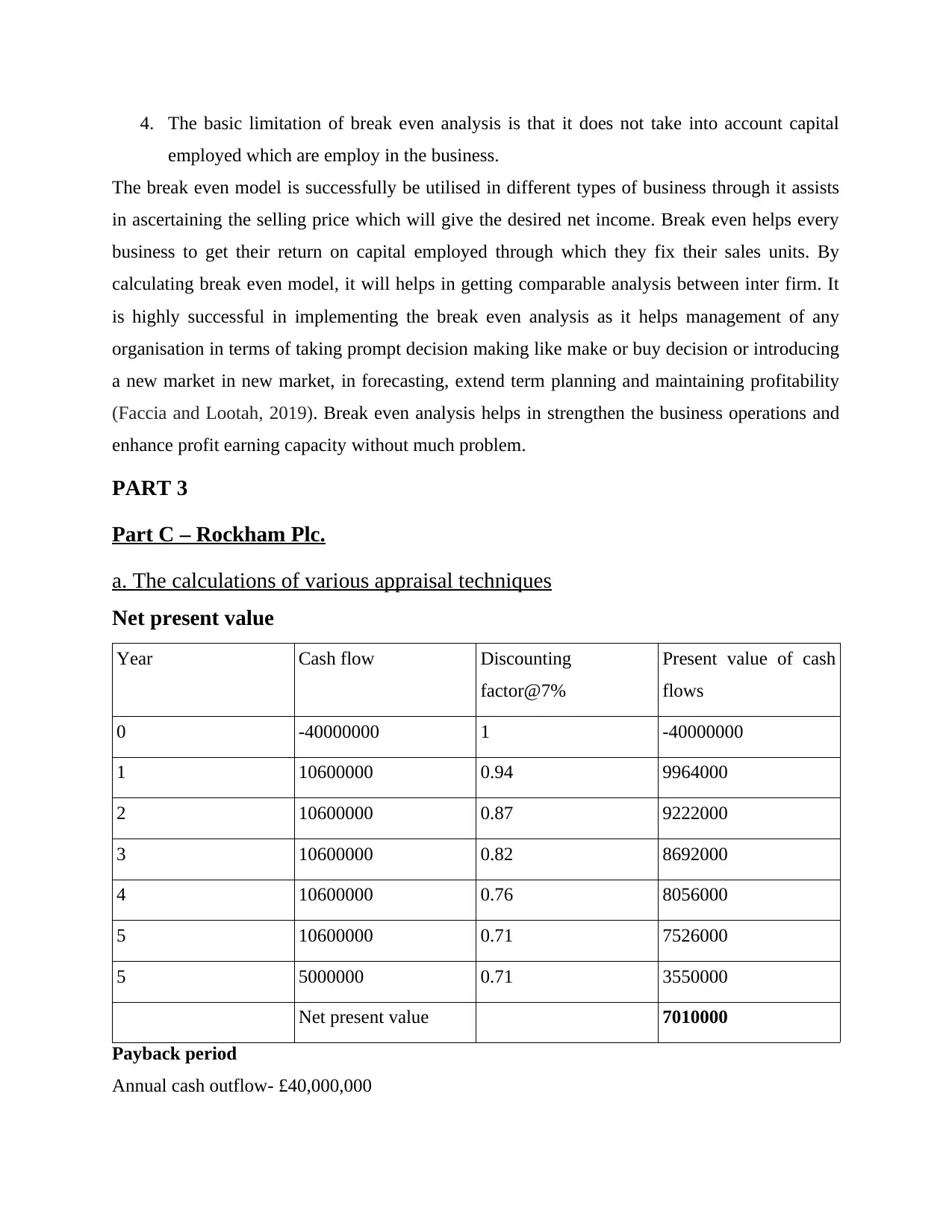
4. The basic limitation of break even analysis is that it does not take into account capital
employed which are employ in the business.
The break even model is successfully be utilised in different types of business through it assists
in ascertaining the selling price which will give the desired net income. Break even helps every
business to get their return on capital employed through which they fix their sales units. By
calculating break even model, it will helps in getting comparable analysis between inter firm. It
is highly successful in implementing the break even analysis as it helps management of any
organisation in terms of taking prompt decision making like make or buy decision or introducing
a new market in new market, in forecasting, extend term planning and maintaining profitability
(Faccia and Lootah, 2019). Break even analysis helps in strengthen the business operations and
enhance profit earning capacity without much problem.
PART 3
Part C – Rockham Plc.
a. The calculations of various appraisal techniques
Net present value
Year Cash flow Discounting
factor@7%
Present value of cash
flows
0 -40000000 1 -40000000
1 10600000 0.94 9964000
2 10600000 0.87 9222000
3 10600000 0.82 8692000
4 10600000 0.76 8056000
5 10600000 0.71 7526000
5 5000000 0.71 3550000
Net present value 7010000
Payback period
Annual cash outflow- £40,000,000
employed which are employ in the business.
The break even model is successfully be utilised in different types of business through it assists
in ascertaining the selling price which will give the desired net income. Break even helps every
business to get their return on capital employed through which they fix their sales units. By
calculating break even model, it will helps in getting comparable analysis between inter firm. It
is highly successful in implementing the break even analysis as it helps management of any
organisation in terms of taking prompt decision making like make or buy decision or introducing
a new market in new market, in forecasting, extend term planning and maintaining profitability
(Faccia and Lootah, 2019). Break even analysis helps in strengthen the business operations and
enhance profit earning capacity without much problem.
PART 3
Part C – Rockham Plc.
a. The calculations of various appraisal techniques
Net present value
Year Cash flow Discounting
factor@7%
Present value of cash
flows
0 -40000000 1 -40000000
1 10600000 0.94 9964000
2 10600000 0.87 9222000
3 10600000 0.82 8692000
4 10600000 0.76 8056000
5 10600000 0.71 7526000
5 5000000 0.71 3550000
Net present value 7010000
Payback period
Annual cash outflow- £40,000,000
⊘ This is a preview!⊘
Do you want full access?
Subscribe today to unlock all pages.

Trusted by 1+ million students worldwide
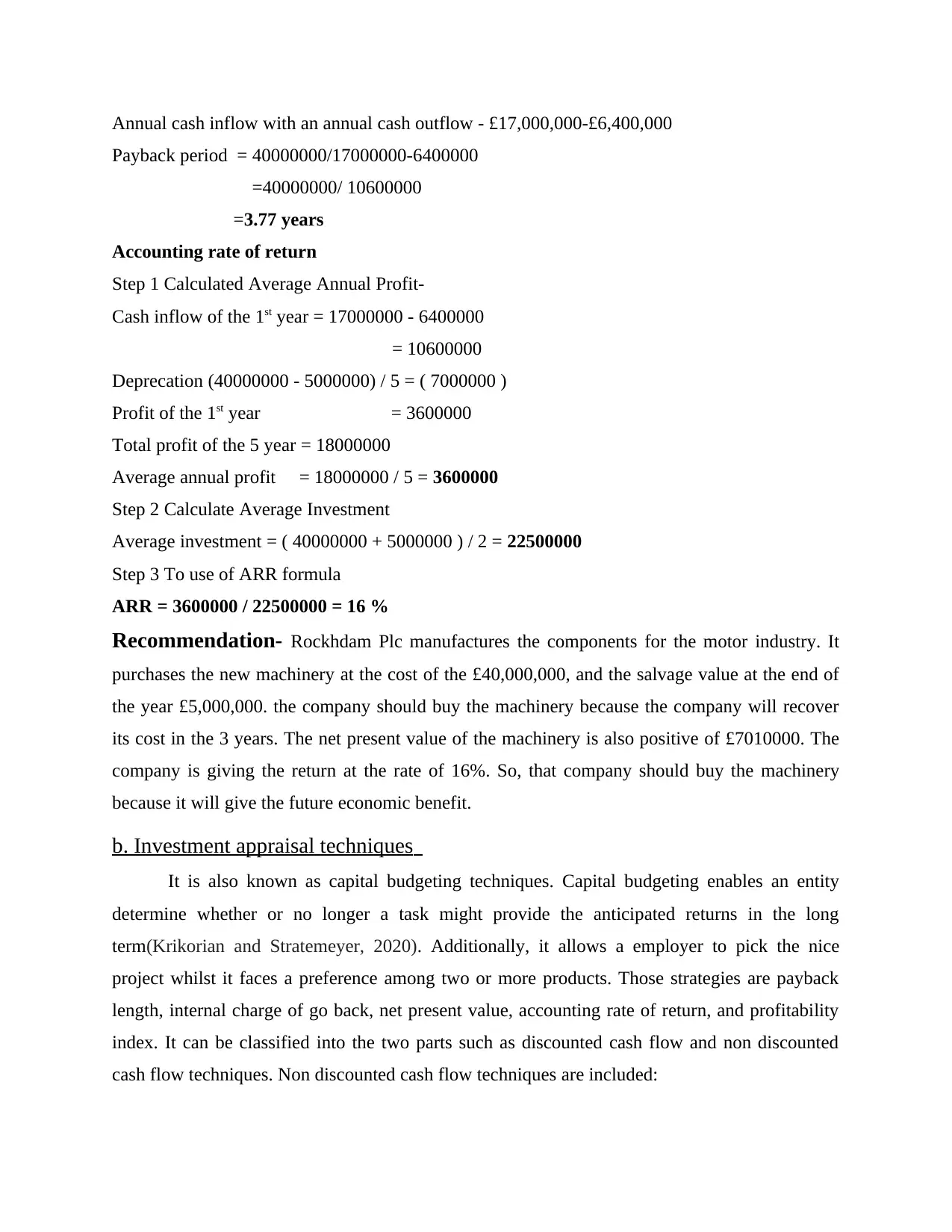
Annual cash inflow with an annual cash outflow - £17,000,000-£6,400,000
Payback period = 40000000/17000000-6400000
=40000000/ 10600000
=3.77 years
Accounting rate of return
Step 1 Calculated Average Annual Profit-
Cash inflow of the 1st year = 17000000 - 6400000
= 10600000
Deprecation (40000000 - 5000000) / 5 = ( 7000000 )
Profit of the 1st year = 3600000
Total profit of the 5 year = 18000000
Average annual profit = 18000000 / 5 = 3600000
Step 2 Calculate Average Investment
Average investment = ( 40000000 + 5000000 ) / 2 = 22500000
Step 3 To use of ARR formula
ARR = 3600000 / 22500000 = 16 %
Recommendation- Rockhdam Plc manufactures the components for the motor industry. It
purchases the new machinery at the cost of the £40,000,000, and the salvage value at the end of
the year £5,000,000. the company should buy the machinery because the company will recover
its cost in the 3 years. The net present value of the machinery is also positive of £7010000. The
company is giving the return at the rate of 16%. So, that company should buy the machinery
because it will give the future economic benefit.
b. Investment appraisal techniques
It is also known as capital budgeting techniques. Capital budgeting enables an entity
determine whether or no longer a task might provide the anticipated returns in the long
term(Krikorian and Stratemeyer, 2020). Additionally, it allows a employer to pick the nice
project whilst it faces a preference among two or more products. Those strategies are payback
length, internal charge of go back, net present value, accounting rate of return, and profitability
index. It can be classified into the two parts such as discounted cash flow and non discounted
cash flow techniques. Non discounted cash flow techniques are included:
Payback period = 40000000/17000000-6400000
=40000000/ 10600000
=3.77 years
Accounting rate of return
Step 1 Calculated Average Annual Profit-
Cash inflow of the 1st year = 17000000 - 6400000
= 10600000
Deprecation (40000000 - 5000000) / 5 = ( 7000000 )
Profit of the 1st year = 3600000
Total profit of the 5 year = 18000000
Average annual profit = 18000000 / 5 = 3600000
Step 2 Calculate Average Investment
Average investment = ( 40000000 + 5000000 ) / 2 = 22500000
Step 3 To use of ARR formula
ARR = 3600000 / 22500000 = 16 %
Recommendation- Rockhdam Plc manufactures the components for the motor industry. It
purchases the new machinery at the cost of the £40,000,000, and the salvage value at the end of
the year £5,000,000. the company should buy the machinery because the company will recover
its cost in the 3 years. The net present value of the machinery is also positive of £7010000. The
company is giving the return at the rate of 16%. So, that company should buy the machinery
because it will give the future economic benefit.
b. Investment appraisal techniques
It is also known as capital budgeting techniques. Capital budgeting enables an entity
determine whether or no longer a task might provide the anticipated returns in the long
term(Krikorian and Stratemeyer, 2020). Additionally, it allows a employer to pick the nice
project whilst it faces a preference among two or more products. Those strategies are payback
length, internal charge of go back, net present value, accounting rate of return, and profitability
index. It can be classified into the two parts such as discounted cash flow and non discounted
cash flow techniques. Non discounted cash flow techniques are included:
Paraphrase This Document
Need a fresh take? Get an instant paraphrase of this document with our AI Paraphraser
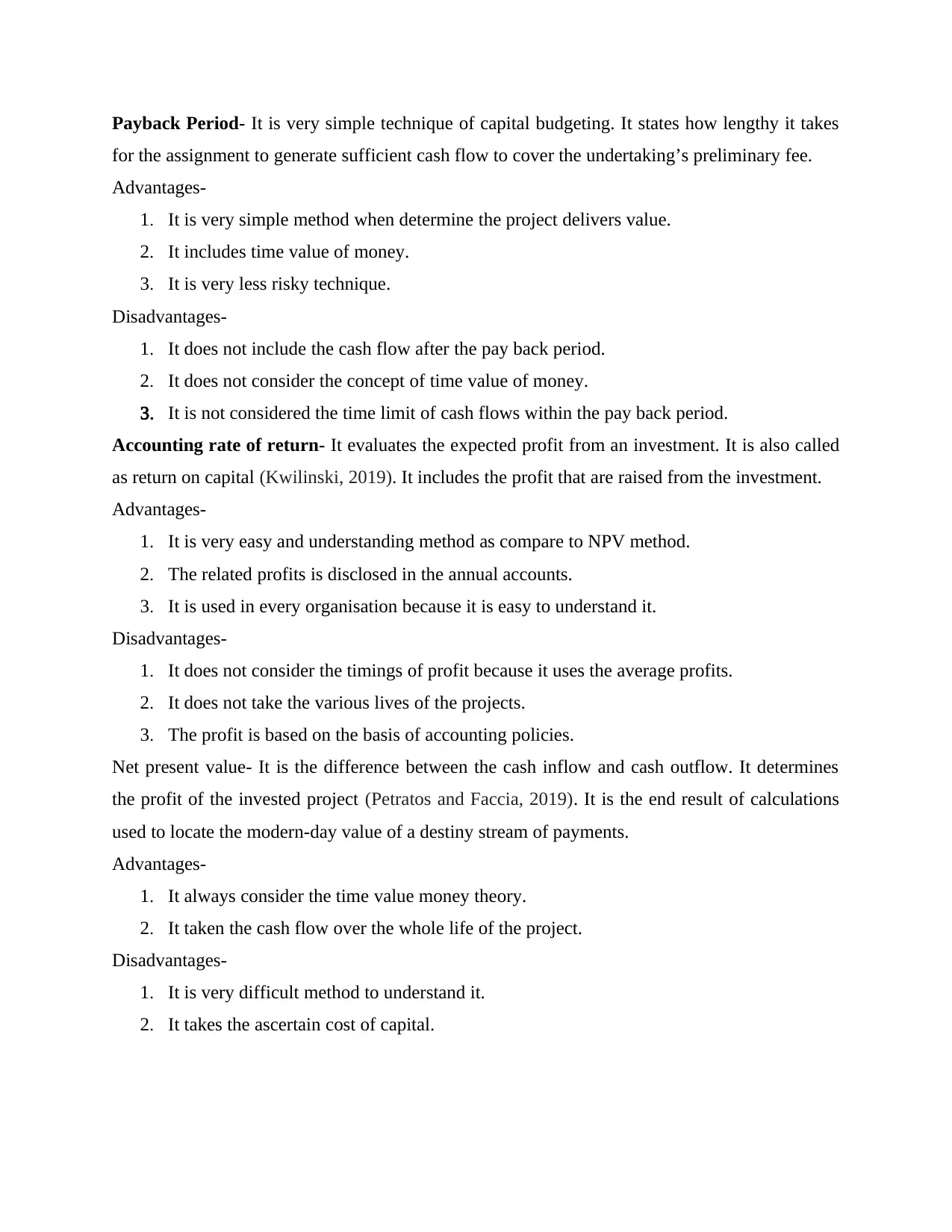
Payback Period- It is very simple technique of capital budgeting. It states how lengthy it takes
for the assignment to generate sufficient cash flow to cover the undertaking’s preliminary fee.
Advantages-
1. It is very simple method when determine the project delivers value.
2. It includes time value of money.
3. It is very less risky technique.
Disadvantages-
1. It does not include the cash flow after the pay back period.
2. It does not consider the concept of time value of money.
3. It is not considered the time limit of cash flows within the pay back period.
Accounting rate of return- It evaluates the expected profit from an investment. It is also called
as return on capital (Kwilinski, 2019). It includes the profit that are raised from the investment.
Advantages-
1. It is very easy and understanding method as compare to NPV method.
2. The related profits is disclosed in the annual accounts.
3. It is used in every organisation because it is easy to understand it.
Disadvantages-
1. It does not consider the timings of profit because it uses the average profits.
2. It does not take the various lives of the projects.
3. The profit is based on the basis of accounting policies.
Net present value- It is the difference between the cash inflow and cash outflow. It determines
the profit of the invested project (Petratos and Faccia, 2019). It is the end result of calculations
used to locate the modern-day value of a destiny stream of payments.
Advantages-
1. It always consider the time value money theory.
2. It taken the cash flow over the whole life of the project.
Disadvantages-
1. It is very difficult method to understand it.
2. It takes the ascertain cost of capital.
for the assignment to generate sufficient cash flow to cover the undertaking’s preliminary fee.
Advantages-
1. It is very simple method when determine the project delivers value.
2. It includes time value of money.
3. It is very less risky technique.
Disadvantages-
1. It does not include the cash flow after the pay back period.
2. It does not consider the concept of time value of money.
3. It is not considered the time limit of cash flows within the pay back period.
Accounting rate of return- It evaluates the expected profit from an investment. It is also called
as return on capital (Kwilinski, 2019). It includes the profit that are raised from the investment.
Advantages-
1. It is very easy and understanding method as compare to NPV method.
2. The related profits is disclosed in the annual accounts.
3. It is used in every organisation because it is easy to understand it.
Disadvantages-
1. It does not consider the timings of profit because it uses the average profits.
2. It does not take the various lives of the projects.
3. The profit is based on the basis of accounting policies.
Net present value- It is the difference between the cash inflow and cash outflow. It determines
the profit of the invested project (Petratos and Faccia, 2019). It is the end result of calculations
used to locate the modern-day value of a destiny stream of payments.
Advantages-
1. It always consider the time value money theory.
2. It taken the cash flow over the whole life of the project.
Disadvantages-
1. It is very difficult method to understand it.
2. It takes the ascertain cost of capital.
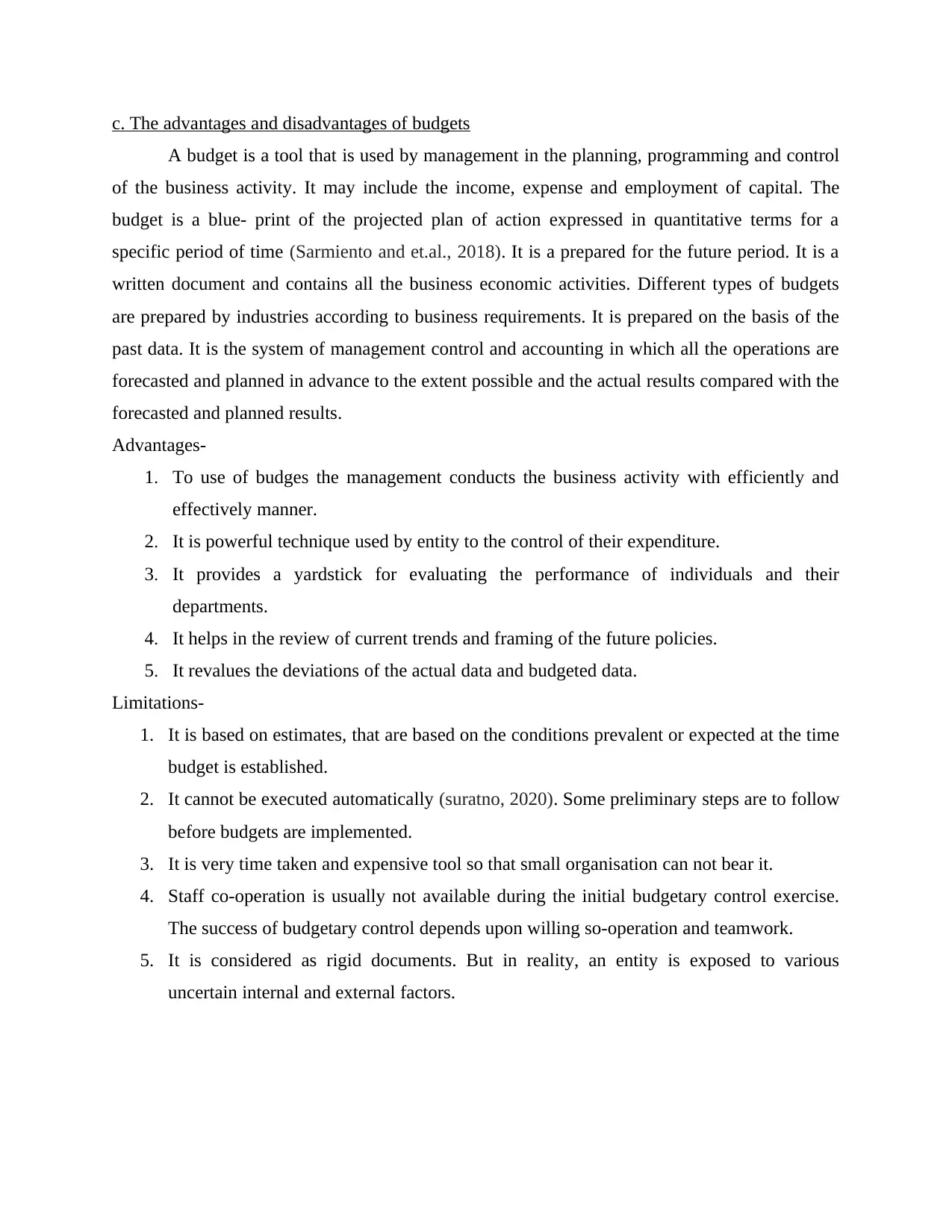
c. The advantages and disadvantages of budgets
A budget is a tool that is used by management in the planning, programming and control
of the business activity. It may include the income, expense and employment of capital. The
budget is a blue- print of the projected plan of action expressed in quantitative terms for a
specific period of time (Sarmiento and et.al., 2018). It is a prepared for the future period. It is a
written document and contains all the business economic activities. Different types of budgets
are prepared by industries according to business requirements. It is prepared on the basis of the
past data. It is the system of management control and accounting in which all the operations are
forecasted and planned in advance to the extent possible and the actual results compared with the
forecasted and planned results.
Advantages-
1. To use of budges the management conducts the business activity with efficiently and
effectively manner.
2. It is powerful technique used by entity to the control of their expenditure.
3. It provides a yardstick for evaluating the performance of individuals and their
departments.
4. It helps in the review of current trends and framing of the future policies.
5. It revalues the deviations of the actual data and budgeted data.
Limitations-
1. It is based on estimates, that are based on the conditions prevalent or expected at the time
budget is established.
2. It cannot be executed automatically (suratno, 2020). Some preliminary steps are to follow
before budgets are implemented.
3. It is very time taken and expensive tool so that small organisation can not bear it.
4. Staff co-operation is usually not available during the initial budgetary control exercise.
The success of budgetary control depends upon willing so-operation and teamwork.
5. It is considered as rigid documents. But in reality, an entity is exposed to various
uncertain internal and external factors.
A budget is a tool that is used by management in the planning, programming and control
of the business activity. It may include the income, expense and employment of capital. The
budget is a blue- print of the projected plan of action expressed in quantitative terms for a
specific period of time (Sarmiento and et.al., 2018). It is a prepared for the future period. It is a
written document and contains all the business economic activities. Different types of budgets
are prepared by industries according to business requirements. It is prepared on the basis of the
past data. It is the system of management control and accounting in which all the operations are
forecasted and planned in advance to the extent possible and the actual results compared with the
forecasted and planned results.
Advantages-
1. To use of budges the management conducts the business activity with efficiently and
effectively manner.
2. It is powerful technique used by entity to the control of their expenditure.
3. It provides a yardstick for evaluating the performance of individuals and their
departments.
4. It helps in the review of current trends and framing of the future policies.
5. It revalues the deviations of the actual data and budgeted data.
Limitations-
1. It is based on estimates, that are based on the conditions prevalent or expected at the time
budget is established.
2. It cannot be executed automatically (suratno, 2020). Some preliminary steps are to follow
before budgets are implemented.
3. It is very time taken and expensive tool so that small organisation can not bear it.
4. Staff co-operation is usually not available during the initial budgetary control exercise.
The success of budgetary control depends upon willing so-operation and teamwork.
5. It is considered as rigid documents. But in reality, an entity is exposed to various
uncertain internal and external factors.
⊘ This is a preview!⊘
Do you want full access?
Subscribe today to unlock all pages.

Trusted by 1+ million students worldwide
1 out of 14
Related Documents
Your All-in-One AI-Powered Toolkit for Academic Success.
+13062052269
info@desklib.com
Available 24*7 on WhatsApp / Email
![[object Object]](/_next/static/media/star-bottom.7253800d.svg)
Unlock your academic potential
Copyright © 2020–2025 A2Z Services. All Rights Reserved. Developed and managed by ZUCOL.




